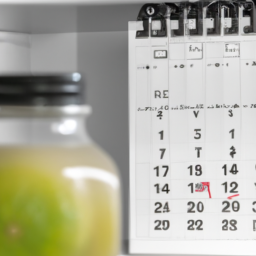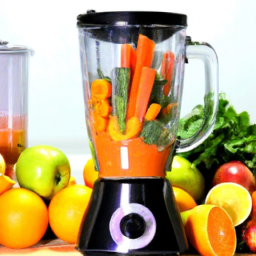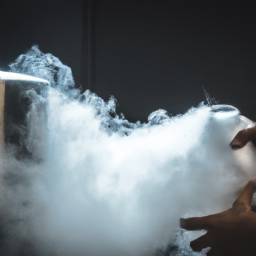Being a huge fan of all things citrus, I am always looking for ways to incorporate lemon juice into my dishes. Unfortunately, manually squeezing juice from fresh lemons can be time-consuming, so I often resort to using pre-bottled or concentrated lemon juice.
However, I’ve always wondered how long these options can last after opening. After all, no one wants to ruin a dish with spoiled lemon juice.
Luckily, I’ve done some research and have the answers. In this article, I’ll go over the different types of lemon juice, the factors that affect their shelf life, and how long each type can last after opening.
Plus, I’ll share tips for extending the shelf life of lemon juice and how to know when it’s gone bad. So whether you’re a home cook or a professional chef, read on to make sure your lemon juice stays fresh and delicious.
Key Takeaways
- Freshly squeezed lemon juice lasts 2-3 days in the refrigerator.
- Bottled lemon juice lasts up to 12 months in the refrigerator.
- Refrigerate opened bottled or concentrated lemon juice to extend shelf life.
- Frozen freshly squeezed lemon juice can last up to 6 months.
Different Types of Lemon Juice
So, you’ve got a bottle of lemon juice open and you’re wondering how long it’ll last. Well, it depends on the type of lemon juice you have!
There are different types of lemon juice, such as freshly squeezed, concentrated, and bottled lemon juice. Freshly squeezed lemon juice, which is the most natural form of lemon juice, has a short shelf life of only 2-3 days when refrigerated.
On the other hand, concentrated lemon juice can last for up to 6 months in the refrigerator. Bottled lemon juice, which is typically pasteurized and contains preservatives, can last for up to 12 months in the refrigerator.
If you’re running out of lemon juice, you can substitute it with other citrus juices such as lime, grapefruit, and orange. Lemon juice substitutes can add a unique flavor to your dishes and can be used in cocktails, marinades, and dressings.
Moreover, lemon juice is known for its health benefits, which include aiding digestion, boosting the immune system, and improving skin health. So, it’s always good to have some lemon juice on hand, but make sure to check the expiration date and type of lemon juice you have to ensure its freshness and quality.
Moving on to the next section, there are certain factors that affect the shelf life of lemon juice.
Factors That Affect Shelf Life
One cannot ignore the impact of various factors on how well lemon juice holds up over time, be it in terms of taste or quality. Factors affecting spoilage include exposure to air, light, and heat, as well as the presence of microorganisms. These factors can cause the lemon juice to spoil quickly, leading to a sour taste and unpleasant odor.
Proper storage methods can significantly extend the shelf life of lemon juice. Storing lemon juice in an airtight container in the refrigerator can help slow down the growth of microorganisms and prevent oxidation. It’s also essential to use clean utensils when handling the juice to prevent contamination.
By following these guidelines, you can enjoy fresh and flavorful lemon juice for an extended period. So, how long does freshly squeezed lemon juice last? Let’s find out in the next section.
How Long Does Freshly Squeezed Lemon Juice Last?
If you’re a fan of using freshly squeezed lemon juice in your recipes, you’ll want to know how long it will maintain its optimal freshness and flavor. Generally, freshly squeezed lemon juice can last up to 2-3 days in the refrigerator if stored in a tightly sealed container. However, its shelf life can vary depending on factors such as temperature, exposure to air, and the overall quality of the lemons used.
To extend the shelf life of freshly squeezed lemon juice, there are several options available. One is to freeze the juice in ice cube trays, which will allow you to use it for up to 6 months after the initial squeeze. Another option is to use lemon juice substitutes, such as bottled lemon juice or citric acid, which have a longer shelf life and can be stored for up to a year or more. With these options, you can ensure that you always have a fresh source of lemon juice on hand for your cooking and baking needs.
Moving on to the next section, it’s important to note that bottled lemon juice has a longer shelf life compared to freshly squeezed lemon juice. But how long can it last?
How Long Does Bottled Lemon Juice Last?
In my experience, bottled lemon juice is a staple in most kitchens, as it eliminates the need to constantly squeeze fresh lemons.
If you have an unopened bottle of lemon juice, it can last up to two years in the pantry. However, once opened, it should be used within six months and refrigerated to extend its shelf life.
Unopened
When you crack open that bottle of lemon juice, its flavor will burst forth like a ray of sunshine that’s been trapped inside.
But what about the shelf life of unopened lemon juice? The good news is that unopened lemon juice can last for up to 18 months if stored properly. It’s important to keep it in a cool, dry place away from direct sunlight and heat sources. This will help maintain the quality and freshness of the lemon juice.
In addition to proper storage, it’s also important to check the expiration date before purchasing the lemon juice. This will give you an idea of how long it’s been on the shelf before you even take it home.
As long as the bottle remains unopened and hasn’t passed its expiration date, you can be confident in the quality of the lemon juice. However, once the bottle is opened, the clock starts ticking on its shelf life.
Opened
Once you’ve opened the bottle of lemon juice, its flavor and freshness will start to diminish, so make sure to use it up within a few weeks to get the most out of it.
There are a few ways to store lemon juice to ensure it stays fresh for as long as possible. One way is to transfer the juice to a smaller container and tightly seal it before refrigerating. This will help prevent air from getting in and causing the juice to spoil.
Another way is to freeze the juice in ice cube trays and then transfer the cubes to a freezer bag. This way, you can easily thaw only what you need.
In addition to its tangy flavor, lemon juice has many benefits. It’s a great source of vitamin C, which can boost your immune system and help fight off colds and flu. Lemon juice also contains antioxidants, which can help reduce inflammation in the body. Plus, it can add a bright, fresh flavor to many dishes, from salad dressings to marinades.
So, make sure to store your lemon juice properly to get the most out of its flavor and health benefits.
Now, let’s talk about how long concentrated lemon juice lasts.
How Long Does Concentrated Lemon Juice Last?
As someone who frequently uses concentrated lemon juice in my cooking, I’m always mindful of how long it can last before going bad.
When left unopened and stored properly, concentrated lemon juice can last up to 18 months. However, once opened and exposed to air and light, it should be used within six months to ensure its freshness and quality.
Unopened
If you haven’t cracked open that bottle of lemon juice yet, you’re in luck because it’s good to go for at least six months.
The shelf life of unopened lemon juice can be extended if stored properly in a cool and dry place, away from direct sunlight. It’s also recommended to keep the bottle tightly sealed to prevent oxidation and maintain its quality.
When it comes to storage recommendations for unopened lemon juice, it’s best to refer to the packaging for any specific instructions. However, in general, keeping the bottle in the pantry or refrigerator is a safe bet. Just make sure to avoid placing it near any strong-smelling foods, which may affect the flavor of the lemon juice.
Now that you know how to properly store unopened lemon juice, let’s move on to what happens when you crack it open.
Opened
Now that you’ve opened that bottle of lemon juice, it’s important to know how to properly store it to ensure it stays fresh and tasty for as long as possible. Here are some tips on how to store your opened lemon juice:
-
Store it in the refrigerator: Once opened, lemon juice should be immediately stored in the refrigerator. The cool temperature will help slow down the oxidation process and prevent bacterial growth, ensuring the juice stays fresh for longer.
-
Use an airtight container: Oxygen is one of the main culprits of spoilage, so it’s important to store lemon juice in an airtight container. This will prevent air from getting in and oxidizing the juice, which could affect its taste and quality.
-
Consider freezing it: If you have leftover lemon juice that you’re not planning on using anytime soon, consider freezing it in an ice cube tray. This way, you’ll have small portions of lemon juice that you can easily thaw and use in recipes or drinks as needed.
Aside from its culinary uses, lemon juice also has many health benefits. It’s rich in vitamin C, which is essential for a healthy immune system and can help prevent colds and other illnesses. Lemon juice also contains antioxidants that can help protect against cell damage, and it may even aid in digestion and weight loss. So, make sure to incorporate lemon juice into your diet whenever possible.
Next, let’s talk about the signs that lemon juice has gone bad.
Signs That Lemon Juice Has Gone Bad
Like a wilting flower, lemon juice that has gone bad will have a sour smell and a cloudy appearance. It is important to pay attention to these signs to avoid consuming spoiled lemon juice. Common contaminants that may cause the spoilage of lemon juice include bacteria, mold, and yeast. These contaminants can lead to health risks such as food poisoning, which can cause symptoms such as nausea, vomiting, and diarrhea.
To avoid these risks, it is important to properly store lemon juice. Lemon juice should be stored in a tightly sealed container in the refrigerator. It is also important to use clean utensils when handling lemon juice to prevent contamination. By following these storage and handling practices, the shelf life of lemon juice can be extended. In the next section, we will discuss some tips for extending the shelf life of lemon juice.
Tips for Extending the Shelf Life of Lemon Juice
To ensure your lemon juice stays fresh for as long as possible, you should store it in a tightly sealed container in the refrigerator and always use clean utensils when handling it. Here are some ways to store lemon juice:
-
Freeze it: Lemon juice can be frozen in ice cube trays or in a plastic container. This method can extend the shelf life of lemon juice for up to 6 months.
-
Use glass bottles: Glass bottles are a great way to store lemon juice as they don’t react with the acid, ensuring the taste and quality of the juice remains unchanged.
-
Keep it away from light: Light can break down the nutrients and flavor of lemon juice, so it’s best to store it in a dark place or in an opaque container.
-
Use fresh lemon juice: The benefits of using fresh lemon juice are numerous. Fresh lemon juice is packed with vitamin C, which boosts the immune system, and it also aids in digestion.
By following these tips, you can extend the shelf life of lemon juice and ensure that you’re using fresh, nutrient-rich juice in your cooking and beverages. Moving forward, it’s important to also be aware of safe handling practices when using lemon juice.
Safe Handling of Lemon Juice
Proper handling techniques are crucial when it comes to utilizing the benefits of fresh lemon juice in cooking and beverages. Safe storage is one of the most important aspects of safe handling. Lemon juice should always be stored in a clean, airtight container and refrigerated immediately after opening.
When using lemon juice, it’s important to avoid cross-contamination by using clean utensils and pouring only the amount needed, instead of putting the utensil back into the container. In addition to safe storage, it’s also important to be aware of lemon juice substitutes.
While fresh lemon juice is ideal, bottled lemon juice can be used as a substitute in many recipes. However, it’s important to check the ingredient list and avoid bottled lemon juice that contains added preservatives or artificial flavors. By following safe handling techniques and being aware of substitutes, you can ensure that your lemon juice remains fresh and safe to use in your favorite recipes.
When it comes to expired lemon juice, there are creative ways to use it beyond cooking and beverages. One idea is to use it as a natural cleaning agent, as the acidity can help remove stains and grime. Another idea is to use it in DIY beauty treatments, such as a hair rinse or face mask. By getting creative, you can still make use of expired lemon juice instead of letting it go to waste.
Creative Ways to Use Expired Lemon Juice
I’ve discovered some creative ways to use expired lemon juice that you might find interesting.
First, you can use it as a cleaning solution thanks to its natural acidity, which makes it great for removing stains, hard water deposits, and grime.
Second, it can also be used as a beauty treatment to brighten and exfoliate your skin, as well as to lighten your hair.
Lastly, expired lemon juice can be a useful gardening hack as it can be used to repel insects, fertilize plants, and prevent mold growth.
Cleaning Solutions
As a symbol of cleanliness and freshness, lemon juice can be a great addition to DIY cleaning solutions. Not only is it a natural alternative to harsh chemicals, but it also has antimicrobial properties that can effectively kill bacteria and germs.
Here are five ways to use lemon juice in your cleaning routine:
- Mix lemon juice with baking soda to create a paste for scrubbing sinks and tubs.
- Add lemon juice to vinegar and water for a multi-purpose cleaning spray.
- Dip a cut lemon in salt and use it to clean copper and brass fixtures.
- Combine lemon juice and olive oil to make a furniture polish.
- Use a mixture of lemon juice and water to clean and deodorize your microwave.
In addition to its cleaning benefits, lemon juice can also be used in various beauty treatments.
Beauty Treatments
Who doesn’t love a good DIY beauty treatment? Lemons can be a great addition to your routine, with their natural cleansing and brightening properties.
Lemon juice can be used to make DIY facials, hair care treatments, and even teeth whitening remedies. It is a natural exfoliant, helping to remove dead skin cells and unclog pores. The citric acid in lemon juice also acts as a natural bleaching agent, helping to lighten dark spots and even out skin tone.
For DIY facials, mix lemon juice with honey and apply to your face for 10-15 minutes before rinsing off with warm water. This can help to brighten and soften skin. For hair care, mix lemon juice with water and use as a rinse after shampooing to help reduce dandruff and add shine to hair. However, it’s important to note that lemon juice can also be drying, so it’s important to use it in moderation and follow up with a moisturizing treatment.
Now, let’s move onto some gardening hacks.
Gardening Hacks
I’ve always been interested in finding ways to make the most out of the items I have around the house. After learning about some beauty treatments that can be made from lemons, I started wondering about other uses for this versatile fruit. That’s when I discovered some amazing gardening hacks that involve using lemon juice for plant propagation and composting techniques.
When it comes to plant propagation, lemon juice can be a game-changer. By using a mix of lemon juice and water, you can create a rooting hormone that helps new plants grow. This is because lemon juice contains citric acid, which helps to stimulate growth and prevent fungal infections. To use this technique, simply dip the cuttings of the plant you want to propagate into the lemon juice mixture, then plant them in soil once roots have formed.
Composting is another area where lemon juice can be useful. The acidity in lemon juice helps to break down organic matter, making it easier to compost. In addition, the scent of lemon can help to mask any unpleasant smells that come from the compost pile. To incorporate lemon juice into your composting routine, simply add some lemon peels to your compost pile or spray a mixture of lemon juice and water onto the pile to help speed up the decomposition process. With these simple gardening hacks, you can make the most of your lemon juice and create a thriving garden in no time.
| Plant Propagation | Composting Techniques |
|---|---|
| Lemon juice and water can be used to make a rooting hormone for new plants. | Lemon peels can be added to compost to help break down organic matter. |
| The citric acid in lemon juice stimulates growth and prevents fungal infections. | Lemon juice can be sprayed onto a compost pile to speed up the decomposition process. |
| Dip plant cuttings into a mixture of lemon juice and water before planting them in soil. | The scent of lemon can mask unpleasant compost smells. |
| Lemon juice is a natural and cost-effective alternative to store-bought rooting hormones. | Incorporating lemon juice into your composting routine can help create nutrient-rich soil for your garden. |
Frequently Asked Questions
Can I freeze lemon juice to extend its shelf life?
Yes, I freeze lemon juice to extend its shelf life. Freezing does not affect the quality of lemon juice, and it can be used for up to 6 months. For concentrated lemon juice, follow the manufacturer’s instructions.
Is it safe to drink expired lemon juice?
Drinking expired lemon juice poses risks associated with food poisoning and quality degradation. Bacteria growth and chemical changes can occur, affecting taste and safety. Always check expiration dates and discard if in doubt.
How does storing lemon juice in a glass container versus a plastic container affect its shelf life?
Storing lemon juice in a glass container can extend its shelf life as compared to plastic storage. Proper refrigeration and adding preservatives like citric acid or ascorbic acid can also help in prolonging its freshness.
Does adding sugar or salt to lemon juice affect its shelf life?
Adding sugar or salt to lemon juice can act as preservatives, extending its shelf life by preventing oxidation. However, the effect is limited and proper storage remains crucial. Other lemon juice oxidation prevention techniques include refrigeration and adding citric acid.
Can I mix expired lemon juice with other ingredients to make a marinade or dressing?
I do not recommend using expired lemon juice in cooking. Instead, consider using it for alternative purposes such as cleaning or as a natural beauty ingredient. Mixing it with other ingredients for marinades or dressings may lead to food safety issues.
Conclusion
In conclusion, keeping lemon juice fresh and safe for consumption requires proper handling, storage, and monitoring of its shelf life. Whether you prefer freshly squeezed, bottled, or concentrated lemon juice, the shelf life can vary depending on several factors.
It’s important to check for signs of spoilage and follow safe handling practices to avoid contamination. Remember, when life gives you lemons, make lemonade!
Don’t let expired lemon juice go to waste, get creative and use it for cleaning, cooking, and even for beauty treatments. Just be sure to use caution and avoid using expired lemon juice for consumption.
With these tips, you can enjoy the refreshing taste of lemon juice for longer. So squeeze away and enjoy the benefits of this versatile fruit!
Ilana has been a vegan for over 10 years. She originally made the switch for health reasons, but soon found herself becoming more and more passionate about the ethical and environmental implications of a vegan lifestyle. Ilana is the author of The Graceful Kitchen, a blog all about veganism. She loves to cook up delicious and nutritious vegan meals, and share her recipes with others who are interested in leading a cruelty-free life. Ilana is also a strong advocate for using whole foods as the foundation of a healthy diet, and believes that going vegan is one of the best ways to achieve this.










